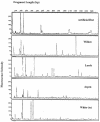Census of the bacterial community of the gypsy moth larval midgut by using culturing and culture-independent methods
- PMID: 14711655
- PMCID: PMC321235
- DOI: 10.1128/AEM.70.1.293-300.2004
Census of the bacterial community of the gypsy moth larval midgut by using culturing and culture-independent methods
Abstract
Little is known about bacteria associated with Lepidoptera, the large group of mostly phytophagous insects comprising the moths and butterflies. We inventoried the larval midgut bacteria of a polyphagous foliivore, the gypsy moth (Lymantria dispar L.), whose gut is highly alkaline, by using traditional culturing and culture-independent methods. We also examined the effects of diet on microbial composition. Analysis of individual third-instar larvae revealed a high degree of similarity of microbial composition among insects fed on the same diet. DNA sequence analysis indicated that most of the PCR-amplified 16S rRNA genes belong to the gamma-Proteobacteria and low G+C gram-positive divisions and that the cultured members represented more than half of the phylotypes identified. Less frequently detected taxa included members of the alpha-Proteobacterium, Actinobacterium, and Cytophaga/Flexibacter/Bacteroides divisions. The 16S rRNA gene sequences from 7 of the 15 cultured organisms and 8 of the 9 sequences identified by PCR amplification diverged from previously reported bacterial sequences. The microbial composition of midguts differed substantially among larvae feeding on a sterilized artificial diet, aspen, larch, white oak, or willow. 16S rRNA analysis of cultured isolates indicated that an Enterococcus species and culture-independent analysis indicated that an Entbacter sp. were both present in all larvae, regardless of the feeding substrate; the sequences of these two phylotypes varied less than 1% among individual insects. These results provide the first comprehensive description of the microbial diversity of a lepidopteran midgut and demonstrate that the plant species in the diet influences the composition of the gut bacterial community.
Figures
References
-
- Aksoy, S. 1995. Molecular characteristics of the endosymbionts of the tsetse flies: 16S rRNA locus and over-expression of chaperonins. Insect Molec. Biol. 4:23-29. - PubMed
-
- Altschul, S. F., W. Gish, W. Miller, E. W. Meyers, and D. J. Lipman. 1990. Basic local alignment search tool. J. Molec. Biol. 215:403-410. - PubMed
-
- Ausubel, F. M., B. Roger, R. E. Kingston, D. D. Moore, J. G. Seidman, J. A. Smith, and K. Struhl (ed.). 1994. Current protocols in molecular biology, p. 2.4.1-2.4.5. John Wiley & Sons, Inc., New York, N.Y.
-
- Bandi, C., D. Damiani, L. Magrassi, A. Grigolo, R. Fani, and L. Sacchi. 1994. Flavobacteria as intracellular symbionts in cockroaches. Proc. R. Soc. Lond. 257:43-48. - PubMed
-
- Berenbaum, M. 1980. Adaptive significance of the midgut pH in larval Lepidoptera. Am. Nat. 115:138-146.
Publication types
MeSH terms
Substances
LinkOut - more resources
Full Text Sources
Molecular Biology Databases


